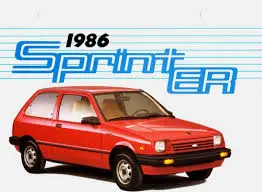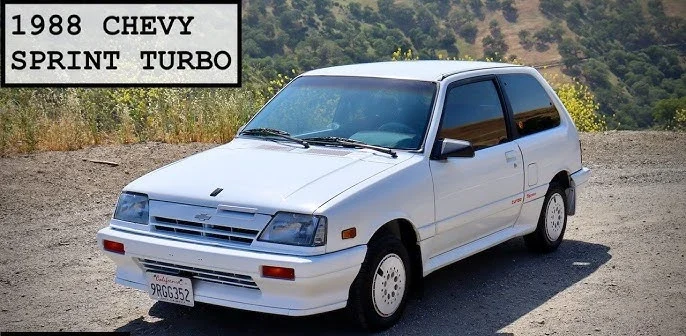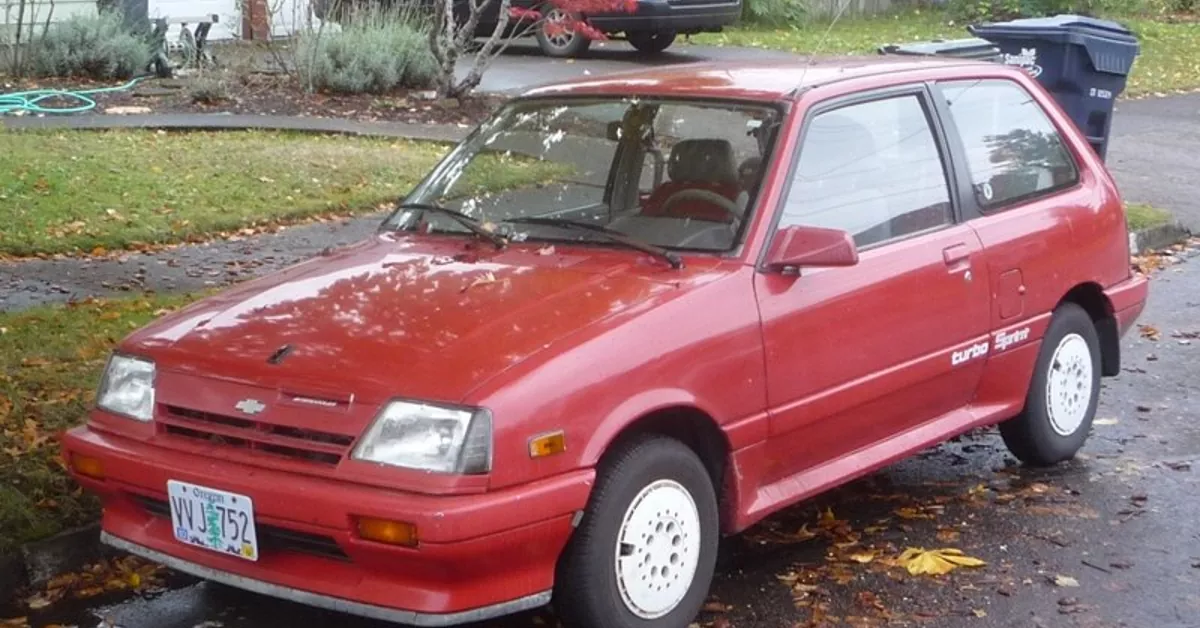The 1980s was a fascinating decade for the automotive world, marked by a shift towards smaller, more fuel-efficient vehicles. Amidst the large sedans and muscle cars, a small but mighty contender emerged: the Chevy Sprint. This compact hatchback, a result of a partnership between General Motors and Suzuki, carved out a unique niche for itself. It was a car celebrated not for raw power, but for its incredible fuel economy, quirky character, and surprisingly fun driving experience.
This article explores the history and legacy of the Chevy Sprint. We’ll look at its origins, the different models that were released over the years, and what made the turbocharged version a fan favorite. We will also touch on common misconceptions, like the confusion with the Chevy Sprinter van, and discuss the availability of Chevy Sprint parts for enthusiasts today.
Key Takeaways
- The Chevy Sprint was a rebadged Suzuki Cultus, sold by Chevrolet in North America from 1984 to 1988.
- It was primarily known for its exceptional fuel efficiency, thanks to its lightweight design and small engine.
- The lineup included a peppy Chevy Sprint Turbo model, which offered a significant performance boost.
- The Sprint is often remembered for its distinctive 3 cylinder Chevy Sprint engine.
- It is not related to the Chevy Sprinter van, which is a larger commercial vehicle.
The Birth of the Chevy Sprint
The story begins in the early 1980s, a time when American automakers were grappling with the after-effects of the 1970s oil crises. There was a growing demand for economical cars, and General Motors sought a quick entry into this market segment. Instead of developing a new model from scratch, GM formed a strategic partnership with Japanese automaker Suzuki. This collaboration allowed GM to import and rebrand the Suzuki Cultus, a popular subcompact car in Japan.
For the North American market, this car was introduced. It made its debut in late 1984 as a 1985 model. Initially, it was only available on the West Coast of the United States. Its small size, lightweight construction, and tiny engine were a stark contrast to the typical Chevrolet lineup of the era. The primary appeal was its incredible gas mileage, often exceeding 50 miles per gallon on the highway, making it one of the most fuel-efficient cars available at the time.
A Partnership for Efficiency
The GM-Suzuki partnership was a classic example of badge engineering. This practice allowed Chevrolet to offer a competitive small car without the massive investment required for research and development. The Sprint was built by Suzuki in Japan and shipped to the US, where it was sold through Chevrolet dealerships. This arrangement gave American consumers a reliable and economical option that carried the familiar Chevy bowtie emblem, building trust and attracting buyers who might have been hesitant to purchase a foreign brand.
Decoding the Model Years: 1985-1988
It had a relatively short but memorable production run in the United States, spanning from the 1985 Chevy Sprint to the 1988 Chevy Sprint. While the core concept remained the same, each model year brought subtle changes and expanded options.
The Inaugural Model: 1985 Chevy Sprint
The 1985 Chevy Sprint set the stage for what the car was all about: simplicity and efficiency. It was launched as a three-door hatchback powered by a 1.0-liter, 3-cylinder engine. This little powerhouse produced a modest 48 horsepower, but in a car that weighed just over 1,500 pounds, it was surprisingly nimble for city driving. The interior was basic, with functionality taking precedence over luxury. Standard features were minimal, but that was part of its low-cost charm. Its main selling point was its fuel economy, which was a huge draw for budget-conscious buyers.

Growing Up: The 1986 Chevy Sprint
For the 1986 Chevy Sprint, Chevrolet introduced the Sprint Plus, a five-door hatchback version. This new body style added a significant dose of practicality, making the car a more viable option for small families or those who needed easier access to the rear seats. The core mechanical components remained largely unchanged, with the reliable 3 cylinder Chevy Sprint engine continuing to be the standard powertrain. The introduction of the five-door model broadened the Sprint’s appeal and showed that Chevrolet was committed to developing the model line.
The Peak of Performance: The 1987 Chevy Sprint Turbo
The most exciting development in the Sprint’s history arrived with the 1987 Chevy Sprint Turbo. This model took the lightweight platform and gave it a much-needed injection of power. The Chevy Turbo Sprint featured a turbocharged and intercooled version of the 1.0-liter three-cylinder engine. This boosted output to 70 horsepower, a nearly 50% increase over the base model. Paired with a five-speed manual transmission, the Chevy Sprint Turbo could go from 0 to 60 mph in under 10 seconds, making it a legitimate “pocket rocket” of its time. It also featured unique body trim, a hood scoop, and alloy wheels that set it apart from the standard models.
The Final Year: 1988 Chevy Sprint
The 1988 Chevy Sprint marked the final year for the nameplate before it was replaced by the Geo Metro. By this point, the Sprint had established itself as a reliable and economical choice. The lineup continued to offer the base three-door, the five-door Sprint Plus, and the sporty Turbo model. While no major changes were introduced for its final year, the 1988 Chevy Sprint represented the most refined version of the car, benefiting from several years of minor tweaks and improvements. It was a fitting end for a car that had successfully filled a crucial gap in Chevrolet’s portfolio.
The Heart of the Matter: The 3 Cylinder Chevy Sprint Engine
At the core of the it’s identity was its unique engine. The standard models were equipped with a 993cc (1.0-liter) inline three-cylinder engine. This was a novelty for many American drivers who were accustomed to larger V6 and V8 engines. The 3 cylinder Chevy Sprint engine was an all-aluminum design, which contributed to the car’s impressively low curb weight.
This small engine was designed with a clear focus on fuel efficiency. Its simple construction made it reliable and easy to maintain. While its 48-horsepower output seems low by modern standards, it was perfectly adequate for the lightweight Chevy Sprint car. The engine’s distinctive thrumming sound became a signature trait of the vehicle, adding to its quirky charm. For drivers who prioritized miles per gallon over miles per hour, this little engine was a masterpiece of frugal engineering.
The “Pocket Rocket”: All About the Chevy Sprint Turbo
While the base Sprint was praised for its economy, the Chevy Sprint Turbo was the model that captured the hearts of enthusiasts. Introduced for the 1987 model year, this version transformed the mild-mannered hatchback into a surprisingly quick and entertaining ride. The 1987 Chevy Sprint Turbo was more than just an engine upgrade; it was a complete performance package that delivered a thrilling driving experience on a budget.
The key was the addition of an IHI RHB32 turbocharger and an air-to-air intercooler to the 1.0-liter three-cylinder engine. This setup, combined with fuel injection, boosted the horsepower to 70 and torque to 79 lb-ft. In a car weighing only about 1,600 pounds, this power-to-weight ratio resulted in zippy acceleration. The Chevy Turbo Sprint also came with a sport-tuned suspension, wider tires, and a unique body kit with a prominent hood scoop that fed air to the intercooler. It was a fun, tossable car that proved you didn’t need a big engine to have a good time behind the wheel.
Performance Specifications: Base vs. Turbo
| Feature | 1987 Chevy Sprint (Base) | 1987 Chevy Sprint Turbo |
|---|---|---|
| Engine | 1.0L Inline 3-Cylinder | 1.0L Turbocharged Inline 3-Cylinder |
| Horsepower | 48 hp | 70 hp |
| Torque | 57 lb-ft | 79 lb-ft |
| 0-60 mph (approx.) | ~14-15 seconds | ~9.5 seconds |
| Transmission | 5-Speed Manual | 5-Speed Manual |
| Curb Weight | ~1,521 lbs | ~1,633 lbs |
Chevy Sprint vs. Chevy Sprinter Van: Clearing Up the Confusion
One common point of confusion for those unfamiliar with Chevrolet’s historical lineup is the name similarity between the Chevy Sprint and the Chevy Sprinter van. It is important to clarify that these are two completely different vehicles from different eras and with different purposes.
The Chevy Sprint was a subcompact hatchback sold in the 1980s. It was designed for personal transportation with a focus on fuel economy. In contrast, the vehicle often referred to as the Chevy Sprinter van was a full-size commercial van. This van was actually a rebadged version of the Mercedes-Benz Sprinter, sold under the Chevrolet and Dodge brands in the North American market for a period in the 2000s. It was designed for commercial use, such as cargo transport and passenger shuttle services. So, if you’re looking for a tiny, fuel-sipping hatchback, you’re thinking of the Sprint. If you need a large van for your business, you might be thinking of the Express or the rebadged Sprinter from that era.
The Chevy Sprint as a Cult Classic
Today, it has achieved cult classic status among certain automotive enthusiasts. Its combination of rarity, quirky design, and incredible fuel efficiency makes it a unique collector’s item. The turbo models, in particular, are highly sought after for their “sleeper” performance potential.
Owners and fans of the Chevy Sprint car appreciate its simplicity and the direct connection it offers to the road. In an age of complex, computer-controlled vehicles, the Sprint is a refreshing reminder of a time when cars were lighter, simpler, and mechanically straightforward. Online forums and owner groups are dedicated to preserving these vehicles, sharing tips on maintenance, and celebrating their unique place in automotive history.

Finding Chevy Sprint Parts Today
Keeping a classic car from the 1980s on the road can be a challenge. Finding Chevy Sprint parts requires a bit of resourcefulness. Since the car was a rebadged Suzuki, many mechanical parts are interchangeable with the Suzuki Cultus and its other global variants, like the Pontiac Firefly.
Here are some places to look for Chevy Sprint parts:
- Online Marketplaces: Websites like eBay often have listings for both new old stock (NOS) and used parts.
- Specialty Forums: Online communities dedicated to the Sprint, Geo Metro, and Suzuki Swift are invaluable resources. Members often sell parts or can point you to reliable suppliers.
- Junkyards: While increasingly rare, you might still find a Sprint or a related model in a local pick-and-pull salvage yard.
- Cross-Referencing Part Numbers: Since the car had many names (Suzuki Forsa, Pontiac Firefly), searching for parts under these names can yield more results.
Body panels and specific trim pieces for the Chevy Sprint Turbo can be particularly hard to find. However, the shared mechanicals with the more common Geo Metro make keeping the engine and drivetrain running a much more manageable task.
Frequently Asked Questions (FAQ)
Q: Was the Chevy Sprint a good car?
A: For its intended purpose, it was an excellent car. It offered outstanding fuel economy, was generally reliable, and was very affordable. The Chevy Sprint Turbo models also added a surprising level of fun and performance.
Q: How many cylinders did it have?
A: The vast majority of these vehicles were powered by a 1.0-liter 3 cylinder Chevy Sprint engine.
Q: Is a Chevy Sprint the same as a Geo Metro?
A: The Geo Metro was the successor to the Chevy Sprint. After the Sprint was discontinued in 1988, GM launched the Geo brand, and the next generation of the Suzuki Cultus was sold as the Geo Metro starting in 1989. They are closely related but are from different generations.
Q: How fast was the Chevy Sprint Turbo?
A: The Chevy Turbo Sprint could accelerate from 0 to 60 mph in about 9.5 seconds and had a top speed of around 104 mph. While not fast by today’s standards, this was very impressive for an economy car in the 1980s.
Q: Are Chevy Sprint parts hard to find?
A: Some specific trim and body parts can be difficult to locate. However, many mechanical Chevy Sprint parts are shared with the more common Geo Metro and Suzuki Swift, making them easier to find.
Conclusion
It may have been a small car, but it left a big impression. It was a product of its time, born from a need for efficiency and affordability. From the ultra-economical base models of the 1985 Chevy Sprint to the thrilling 1987 Chevy Sprint Turbo, the Sprint offered something for a wide range of drivers. It successfully demonstrated that a small, lightweight car could be both practical and enjoyable.
Today, the Chevy Sprint stands as a charming and quirky reminder of a different era in automotive history. It’s a testament to clever engineering, international collaboration, and the enduring appeal of a simple, honest car. For those who remember it or are lucky enough to own one, the Sprint will always be more than just a car; it’s a beloved cult classic that proved big things can come in small packages.

Leave a Reply